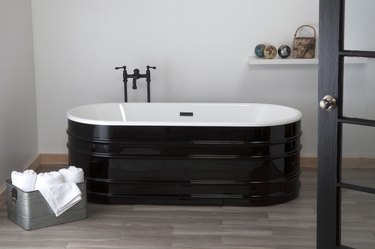In This Article
Looking for an interesting bathroom accent that will go equally well with a farmhouse theme or a retro design? Trying to save money on a bathroom renovation? If either of these sound like you or if you're interested in eco-friendly projects to spruce up your space, there are several unusual materials that can be retrofitted and reused to create interesting new pieces. If you're looking for a statement piece for a bathroom, consider creating a bathtub out of something unusual like a galvanized stock tank.
Galvanized Stock Tank Bathtubs
Video of the Day
Farms use galvanized stock tanks to hold water and feed for their animals. Galvanized steel is steel that has been treated with a protective zinc coating. This layer helps to prevent rust and makes the already-durable steel last longer without corroding. These stock tanks can be used to make unique, creative bathtubs that add style to the bathroom.
Video of the Day
The tanks are normally less expensive than a full bathtub and are available in different sizes. Since the tanks are already built to hold water, there's very little preparation involved. The biggest concern is proper bathtub drainage since the tanks normally come with flat bottoms.
To turn a stock tank into a bathtub, start by purchasing one of the desired size. Using careful measurements, determine where the tub will be placed in the bathroom and where it will need to be connected to the bathtub drain pipe. Depending on the design of your house, you may need to locate the drain pipe through the basement (or lower floor) of the house.
Creating a Tub Drain
Green Workbench explains you should then mark on the tank itself the point where a drain will need to be installed. You'll need to drill a 1.5-inch hole through the bottom of the tank to install the bathtub drain. Drilling through metal can be dangerous, so be sure to use a proper drill bit and a slower speed when doing so.
Protect yourself with safety glasses and position protective materials so you won't be hit by any metal scraps or shards. In very rare cases, drilling through metal can cause a spark, which can lead to a fire, so be sure to remove combustible materials from the area and use caution. Follow the instructions provided with the metal drill bit.
Interiors Addict explains that, after drilling the hole, you can install the drain fixture. The fitting comes with rubber gaskets and should be caulked properly to avoid leaking. Install the drain stopper according to the manufacturer's instructions. Connect the tub drain to the house drain pipe using a 1.5-inch PVC pipe and fitting as needed. You may need to cut an additional hole into the bathroom floor to access the drain pipe. If doing so, be sure to seal this up properly as well.
Installing the Faucets
Once the tub is in place, all that's left is to install the faucets. The bathroom may already have faucets or faucet hookups marked for hot and cold water, but depending on the placement of the tub, you may need to replace them with new models to make sure the water reaches and stays inside the tub. This is a standard plumbing job. Follow the manufacturer's instructions to install the faucets.
Keep in mind that the tub itself can be refinished (if reusing an old piece of equipment) or painted before installation to help it stand out even more. Once installed, there's nothing stopping you from having a luxurious bath in your new, unique tub.
